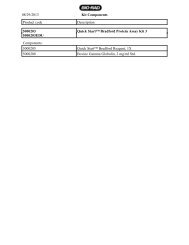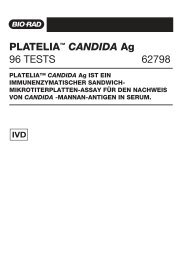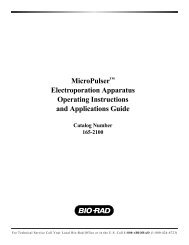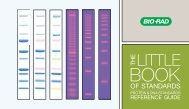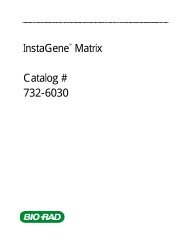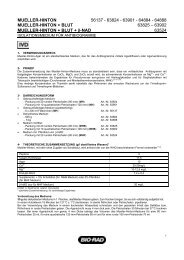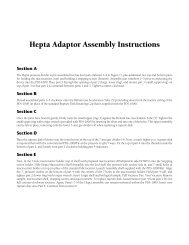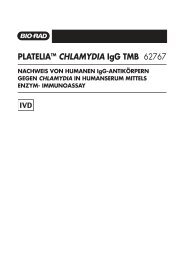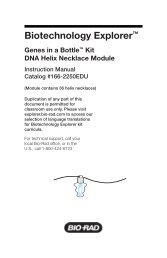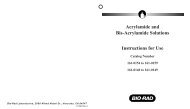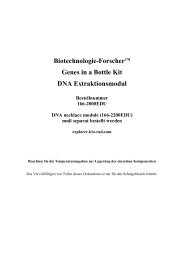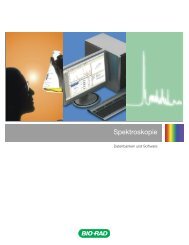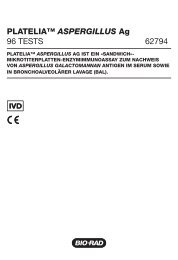Protein Expression and Purification Series - Bio-Rad
Protein Expression and Purification Series - Bio-Rad
Protein Expression and Purification Series - Bio-Rad
You also want an ePaper? Increase the reach of your titles
YUMPU automatically turns print PDFs into web optimized ePapers that Google loves.
<strong>Protein</strong> <strong>Expression</strong> <strong>and</strong> <strong>Purification</strong> <strong>Series</strong><br />
Note to the Instructor<br />
The amount of advance preparation needed will vary greatly depending on the level of the students <strong>and</strong><br />
the goals of the instructor. A detailed description of the preparation required for each laboratory stage is<br />
provided in two chapters at the beginning of the instruction manual: chapters 3A <strong>and</strong> 3B. Please note<br />
that Chapter 3A pertains to the advanced preparation of the Centrifugation <strong>Purification</strong> Process whereas<br />
Chapter 3B pertains to the advanced preparation required for the Chromatography Instrumentation<br />
<strong>Purification</strong> Processes.<br />
St<strong>and</strong>ard techniques: Basic st<strong>and</strong>ard laboratory techniques for preparing, loading <strong>and</strong> running SDS-<br />
PAGE gels; using a SmartSpec Plus spectrophotometer; determining a centrifuge’s RPM; setting up<br />
<strong>Bio</strong>Logic LP or <strong>Bio</strong>Logic DuoFlow instrumentation <strong>and</strong> fraction collectors are included in the appendices<br />
for students or instructors to perform prior to or as part of the laboratory.<br />
Aliquoting reagents: Depending on the level <strong>and</strong> number of students, the instructor may prefer to<br />
prepare aliquots of reagents for student teams or to have students take required reagents from a common<br />
stock. A list of requirements for each student workstation is provided at the start of each section.<br />
Additional requirements <strong>and</strong> information for the instructor at each stage are within individual modules later<br />
in this manual.<br />
Reagents used multiple times: Some of the reagents supplied are used in multiple places in the course.<br />
For example, the 10x PBS provided in the Growth <strong>and</strong> <strong>Expression</strong> module is used in both Chapters 4 <strong>and</strong><br />
7 or 8 for purification, <strong>and</strong> also in Chapter 9 for analysis of DHFR Enzyme Activity. Therefore it is important<br />
that reagents not be discarded following use at a particular stage.<br />
<strong>Protein</strong> expression: The protein expression portion of this laboratory is probably the most difficult part of<br />
this research workflow with respect to timing <strong>and</strong> aligning with class periods. Great care has been taken<br />
to make the protocols as flexible as possible; however, live organisms such as bacteria <strong>and</strong> their growing<br />
cycles can only be managed to some degree. Due to certain class schedules it may be necessary for<br />
students to come in <strong>and</strong> perform some tasks outside of formal class time, or it may be advantageous for<br />
the instructor to perform certain tasks to keep the growth <strong>and</strong> expression activities in progress. These<br />
particular steps are highlighted in Chapters 3 through 5. Please review these sections carefully to obtain<br />
the best possible results for your class.<br />
DHFR enzyme activity: It is important to note that the NADPH cofactor <strong>and</strong> DHF substrate are labile <strong>and</strong><br />
only function three to four hours after being reconstituted. Be sure to prepare these reagents just prior to<br />
performing the enzymatic assay. The reconstituted NADPH <strong>and</strong> DHF reagents are NOT viable after three to<br />
four hours <strong>and</strong> freezing the solutions will not extend their functionality. If multiple classes will be performing<br />
the assay <strong>and</strong> are scheduled more than three to four hours apart, it will be necessary to purchase an<br />
additional DHFR Enzymatic Assay Module.<br />
Helpful hints <strong>and</strong> tips: Please refer to the helpful hints <strong>and</strong> tips guide located in Appendix A for more<br />
useful checks <strong>and</strong> suggestions on how to ensure the most successful experience with this laboratory<br />
series.<br />
Skills Students Need to Perform This Laboratory<br />
The <strong>Protein</strong> <strong>Expression</strong> <strong>and</strong> <strong>Purification</strong> <strong>Series</strong> assumes students <strong>and</strong> instructors have basic molecular<br />
biology <strong>and</strong> microbiology laboratory skills such as loading <strong>and</strong> running SDS-PAGE gels, micropipetting with<br />
care <strong>and</strong> accuracy, pouring <strong>and</strong> streaking agar plates, calculating molarity, etc. Brief protocols for basic<br />
skills are included in the instructor’s advanced preparation section as well as in appendices as reminders,<br />
rather than as thorough lessons. Also, this is not an ideal laboratory to introduce basic skills to students.<br />
The <strong>Bio</strong>-<strong>Rad</strong> <strong>Bio</strong>technology Explorer program has a full range of kits to help teach basic skills in individual<br />
laboratories prior to introducing students to how these separate skills connect into a single workflow, as is<br />
done in this laboratory course.<br />
16 Instructor’s Advance Preparation



